The AMD Ryzen 9 7900, Ryzen 7 7700, and Ryzen 5 7600 Review: Zen 4 Efficiency at 65 Watts
by Gavin Bonshor on January 9, 2023 9:00 AM ESTCPU Benchmark Performance: Power And Office
Our previous sets of ‘office’ benchmarks have often been a mix of science and synthetics, so this time we wanted to keep our office section purely on real-world performance. We've also incorporated our power testing into this section too.
The biggest update to our Office-focused tests for 2023 and beyond include UL's Procyon software, which is the successor to PCMark. Procyon benchmarks office performance using Microsoft Office applications, as well as Adobe's Photoshop/Lightroom photo editing software, and Adobe Premier Pro's video editing capabilities. Due to issues with UL Procyon and the video editing test, we haven't been able to properly run these, but once we identify a fix with UL, we will re-test each chip.
We are using DDR5 memory on the 12th and 13th Gen Core parts, as well as the Ryzen 7000 series, at the following settings:
- DDR5-5600B CL46 - Intel 13th Gen
- DDR5-5200 CL44 - Ryzen 7000
- DDR5-4800 (B) CL40 - Intel 12th Gen
All other CPUs such as Ryzen 5000 and 3000 were tested at the relevant JEDEC settings as per the processor's individual memory support with DDR4.
Power
The nature of reporting processor power consumption has become, in part, a bit of a nightmare. Historically the peak power consumption of a processor, as purchased, is given by its Thermal Design Power (TDP, or PL1). For many markets, such as embedded processors, that value of TDP still signifies the peak power consumption. For the processors we test at AnandTech, either desktop, notebook, or enterprise, this is not always the case.
Modern high-performance processors implement a feature called Turbo. This allows, usually for a limited time, a processor to go beyond its rated frequency. Exactly how far the processor goes depends on a few factors, such as the Turbo Power Limit (PL2), whether the peak frequency is hard coded, the thermals, and the power delivery. Turbo can sometimes be very aggressive, allowing power values 2.5x above the rated TDP.
AMD and Intel have different definitions for TDP that are, broadly speaking, applied the same. The difference comes from turbo modes, turbo limits, turbo budgets, and how the processors manage that power balance. These topics are 10000-12000 word articles in their own right, and we’ve got a few articles worth reading on the topic.
- Why Intel Processors Draw More Power Than Expected: TDP and Turbo Explained
- Talking TDP, Turbo and Overclocking: An Interview with Intel Fellow Guy Therien
- Reaching for Turbo: Aligning Perception with AMD’s Frequency Metrics
- Intel’s TDP Shenanigans Hurts Everyone
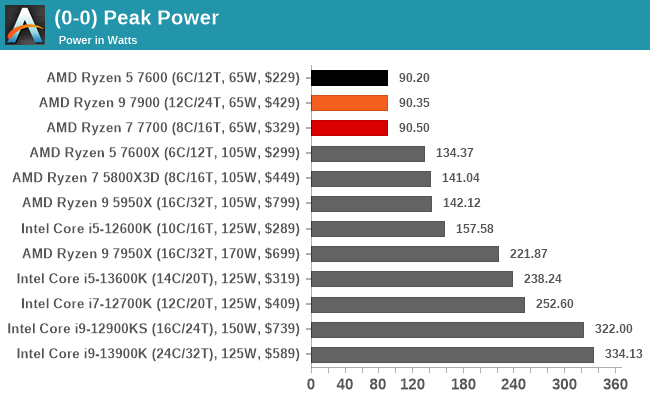
Regarding peak power, all three AMD's Ryzen 7000 65 W series for desktop topped out around 90 W under full load. This figure of 90 W was consistent throughout our power testing, which is within a couple Watts of AMD's Power Package Tracking (PPT) limits (~88W).
Looking at the power consumption of the Ryzen 9 7900 in more detail, we can see how it behaved under full load when running a workload using yCruncher. As we can see from the above graph, when the workload is called, and strain is placed on the Ryzen 9 7900, it immediately rose to 90 W and remained relatively consistent throughout the benchmark. and remained at the 90 W mark for around 193 seconds.
This was the same duration the benchmark took to complete, meaning that the Ryzne 9 7900 remained at its peak power for the full duration.
Office/Web
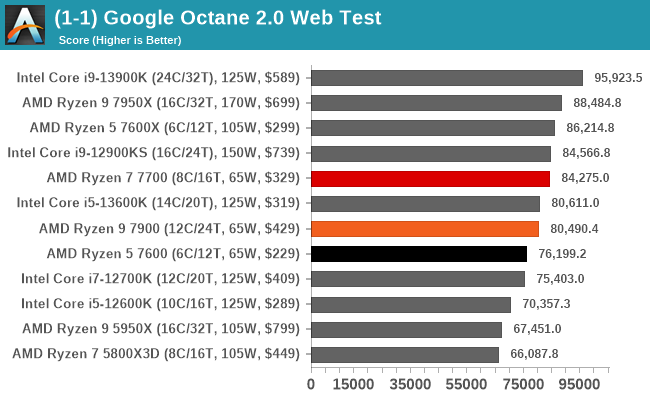
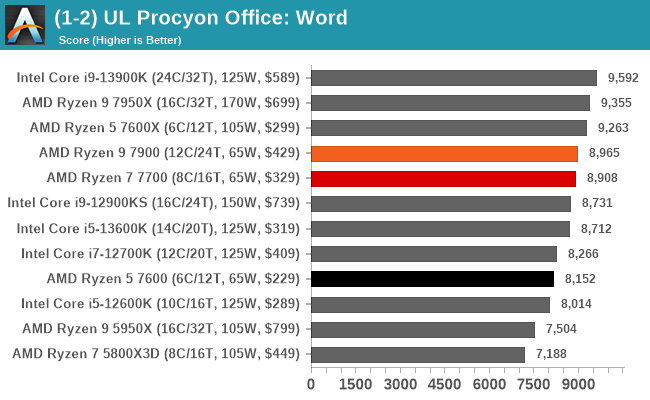
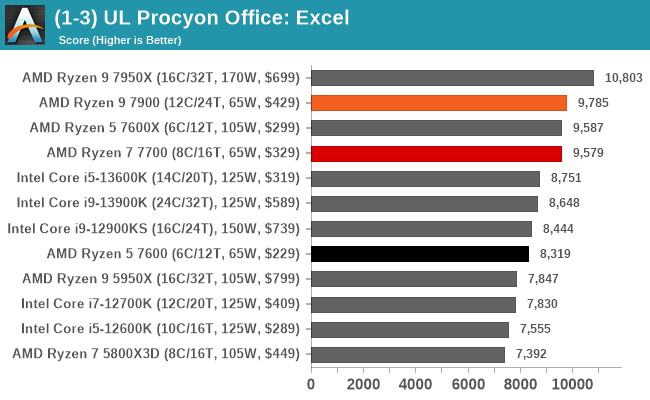
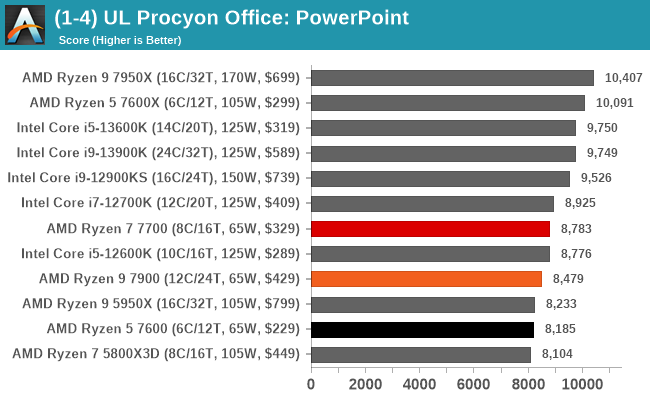
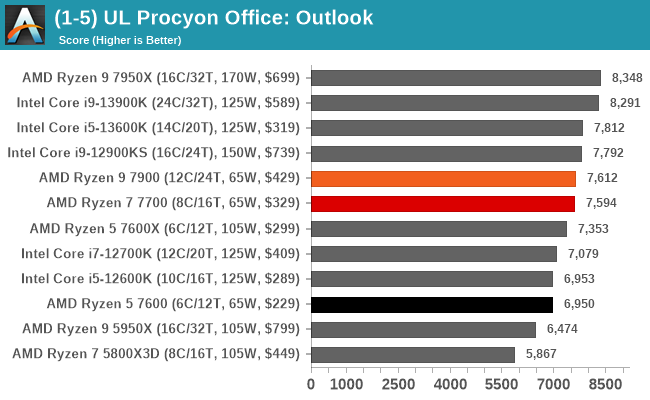
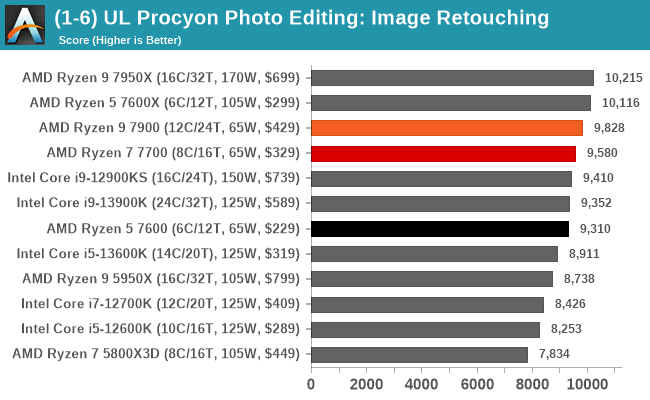
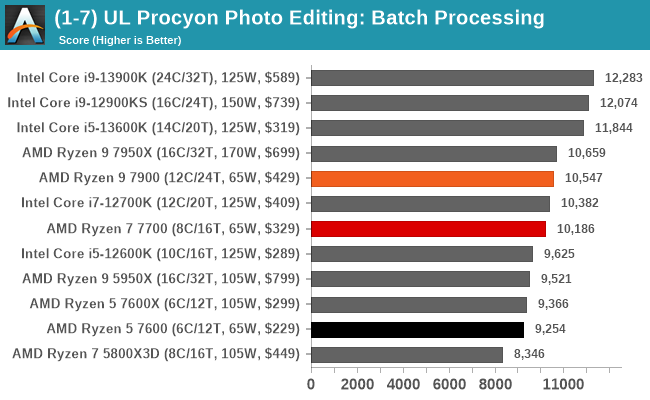
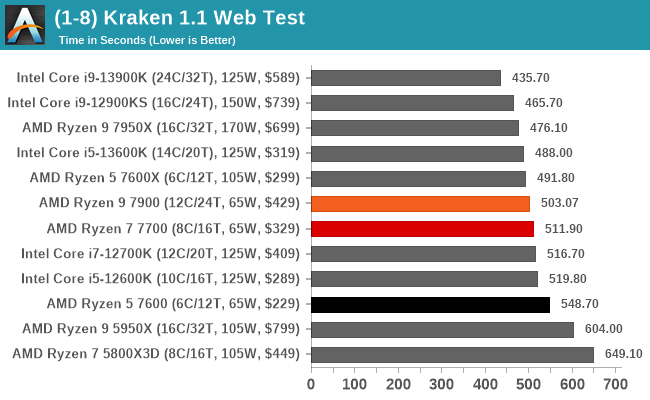
In our office and productivity benchmarks, the AMD Ryzen 9 7900, as expected, performed the best out of the three chips. All three chips in each of the office-based workloads comfortably beat out the Ryzen 9 5950X, which is impressive given the Ryzen 5 7600 is a 6C/12T part at 65 W TDP beating out a much beefier Ryzen 9 5950X that is a 16C/32T part, albeit on an older architecture.


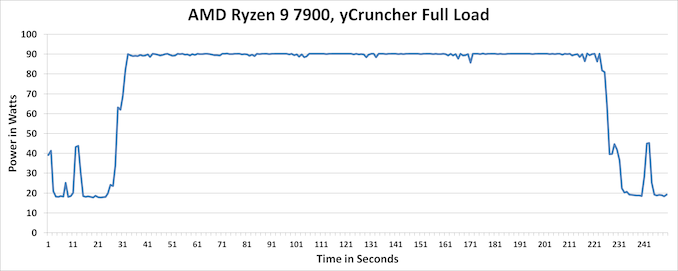








55 Comments
View All Comments
bcortens - Monday, January 9, 2023 - link
Does sustained power consumption look similar to peak power consumption?Why does your article lead with "Efficiency at 65 Watts" when the peak power is 90 Watts?
AshlayW - Monday, January 9, 2023 - link
Because the Platform Power Target (PPT) for '65W TDP' models from AMD has always been around 87W (~90 give or take). The TDP is thermal watts for cooling systems not sustained electrical watts for power usage. I assume the author is implying that the models are the AMD-rated 65W TDP and are efficient, not that they specifically use 65 watts, but I suppose it's kinda misleading.meacupla - Monday, January 9, 2023 - link
yeah, not all the electrical energy going into the chip ends up as heat energy.saratoga4 - Monday, January 9, 2023 - link
All of the electrical energy going into the chip does become heat aside from a tiny bit that leaves as bits on the various buses (which is mostly canceled out by energy coming in from other chips on the same bus). The difference between TDP and peak power is that the CPU can thermally throttle if needed.ballsystemlord - Monday, January 9, 2023 - link
A CPU is not a resistor. So not all the energy is converted into heat.For example, some of it goes down the PCIe bus, and heats up the PCB traces and PCIe card. Likewise with the RAM.
Samus - Wednesday, January 11, 2023 - link
Intel and AMD have dramatically different packaging. The TDP designation in AMD CPU's applies to the CPU portion of the package ie ZEN core chiplet(s) while the IO CCD is rolled into the PPT as it is effectively the rest of the "platform."If we were to try comparing fruits, AMD's PPT would be comparable to Intel's TDP + chipset (Z690 is 6-watts) + other external components that would otherwise be integrated in a Ryzen IO but as these architectures are vastly different a direct comparison is impossible; for example, AMD's IO is far more complex than Intel's, supporting a wider range of platform designs and IO types. While Intel and AMD both support DDR4\5 at this point within their memory controllers, PCIe 3.x\4.x\5.x is handled inside of AMD's IO while Intel offloads much of that to the chipset, only supporting some lanes inside the CPU, and many CPU's not supporting 5.x. To make matters worse, the Z690 is manufactured on a 14nm process while AMD's IO CCD is 7nm (or something like that) so while the Z690 would use much more power if it did the same thing as the AMD IO CCD, it doesn't. In fact it does very little and the package itself is tiny like 25mm2. This means the AMD IO handles a lot more while being 7nm while Intel integrates all of that into the CPU die which is a more refined 10nm process that efficiency is somewhere between TSMC 5nm and 7nm.
Basically AMD's CPU CCD (5nm?) is more efficient while their IO (7nm?) is less efficient and this doesn't entirely balance out compared to Intel's monolithic 10nm (which more efficient than TSMC's 7nm.)
This chart breaks it down better than I can - scroll down to density comparison: https://www.granitefirm.com/blog/us/2021/12/28/tsm...
ballsystemlord - Thursday, January 12, 2023 - link
It's unclear to me how this relates to my post.I was saying that not all the power is turned into heat, therefore, the 90w figure is not misleading.
ballsystemlord - Monday, January 9, 2023 - link
Also worth noting is that the power dissipated is related to the resistance of the component, not the amount of power going into the component. You should recall that from any basic series circuit you have worked with/on.escksu - Tuesday, January 10, 2023 - link
It's true that it's related to resistance but in the case of the cpu, it's mostly due to the rapid switching of transistors.escksu - Tuesday, January 10, 2023 - link
Not all but most of becomes heat. It's due to the rapid switching on/off of the transistors.